All-in-one version
Director’s Message
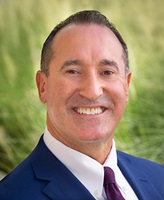
Tony Tavares
Welcome to Mile Marker, Caltrans’ performance journal. In this quarterly publication we share details about a few of the many things we are doing to improve California’s vast and complex transportation system.
Two of the topics we explore in this issue are the state’s tackling of climate change through its embrace of zero-emission vehicles (ZEVs), and the cost savings we continue to accrue through our Caltrans Efficiencies Program.
California is at the forefront of policies that encourage the adoption of ZEVs, support the maturation of the industry, improve access, and ensure communities most impacted by vehicle pollution benefit.
As we all know, the economy relies on mobility, and the future of mobility is emission-free, whether e-bike, transit, bus or semi-truck. Fortunately, we are already seeing significant progress in California. The state has already achieved its passenger ZEV goal of 1.5 million sales nearly two years ahead of schedule.
California is leading the nation with commitments to 100 percent ZEV sales in the passenger vehicle market by 2035 and this spring adopted a policy for 100 percent ZEV truck sales by 2036. These ambitious policies are already generating results and will increase the model availability as we transition our own fleet to ZEVs.
While California is making significant strides in transitioning to a zero-emission future, we must not forget our department's goal to advance equity and livability in all communities. The benefits of zero-emission vehicles go beyond reducing emissions and improving air quality. Funding programs provide critical opportunities to redress and reduce harms in historically overburdened communities and tribal nations.
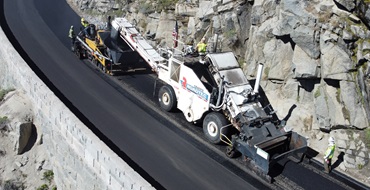 Caltrans' 2022 Echo Summit project along U.S. Highway 50 near Lake Tahoe used an innovative design to accelerate the construction of the bridge. The accelerated schedule and unique design resulted
in a cost savings on some bid items.
Caltrans' 2022 Echo Summit project along U.S. Highway 50 near Lake Tahoe used an innovative design to accelerate the construction of the bridge. The accelerated schedule and unique design resulted
in a cost savings on some bid items.Caltrans drone photograph
Meanwhile, the Efficiencies Program requires Caltrans to achieve at least $100 million in efficiencies each year, as legislated by Senate Bill 1 (SB 1). As noted in the Caltrans Strategic Plan, stewardship and efficiency are key components to realize success as a department and achieve our goals.
There is reason to be proud of, and encouraged by, the dedication and hard work put forth by Caltrans employees. Caltrans set new record highs in Fiscal Year (FY) 2021-22 for the number of new efficiencies (14) and total number of efficiencies (38). I’m extremely proud of our success in this arena and propose we all continue to rise and meet this challenge.
The efficiencies story in this issue spotlights the work of Allen Cripe, lead heavy equipment body worker/painter in the Division of Equipment (DOE). The DOE oversees our fleet equipment, which is composed of more than 12,000 pieces and is tended to by more than 700 employees.
Read how Allen used inspiration, determination, creativity and collaboration to streamline the amount of time, effort and cost to sand and grind the steel parts that work their way through the DOE’s production line. His efforts led to the introduction of “Slingshot Suzie” in Headquarters’ production yard. Suzie’s life expectancy is 40 years, and she is expected to reduce costs by more $50,000 annually through 2056.
With our commitment to a greener future and increased efficiencies, joined as always by our focus on safety and equity, Caltrans continues to do what it can to best serve the people of California and all those who rely on our transportation system.
![]()
Caltrans celebrates landmark anniversary

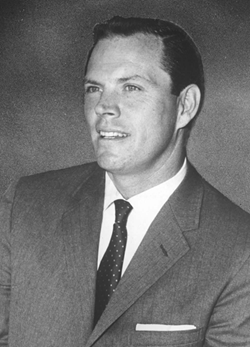
James A. Moe was the last director of Public Works and the first director of Caltrans.
Caltrans Library archives
It was 50 years ago – July 1, 1973 – that several transportation service agencies were brought together to form a unified Caltrans.
Our work to provide a safe, equitable and reliable transportation system has only just started.
By marking the Department of Transportation’s five decades of service that have helped California become the world’s fourth-largest economy, we are inspired to deliver even more positive results in the next 50 years.
Caltrans’ golden anniversary represents more than a look back. It honors our current culture and core values that, in turn, reflect a department more prepared than ever to meet today’s challenges.
Through the expertise and hard work of all its employees, Caltrans will continue to grow, innovate and succeed together through the California State Transportation Agency's (CalSTA's) “Core Four” principles of safety, equity, climate action and economic prosperity.
With these ideals as our guideposts, Caltrans’ decision-making processes and philosophies have evolved to address many pressing issues, including:
- A commitment to innovation in our response to climate change
- Our dedication to connecting people with special places and essential goods and services while protecting the state’s diverse, majestic ecology
- Our faithful desire for inclusivity and transparency in project planning and promoting cultural diversity throughout the department
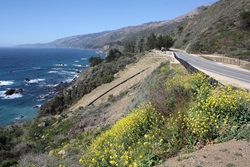
The re-opening of a washed-out portion of State Route 1 at Rat Creek in 2021, a complex task accomplished in less than 100 days, some two months ahead of schedule, is among Caltrans' many dramatic accomplishments.
Caltrans Headquarters photo
Caltrans will address those and other vital issues while remaining steadfastly devoted to our top priority: continuing to build the safest transportation system possible.
These values will work in unison to drive our forward progress.
We’ve seen it all over the last half century, from earthquakes, severe wildfires, and extreme weather to civil unrest and a global pandemic. Caltrans and its 21,000 employees have met each challenge with a sense of duty and pride.
To aid our efforts, we will continue to seek feedback from you and all those we serve – along with, of course, your patience – as we help you continue to move safely across our great state, in any mode you prefer.
And in 2073, when a new generation of idea-makers celebrates Caltrans’ 100th anniversary, they will apply the lessons learned and dedication of those who came before – and understand their work is only beginning.
On behalf of the employees of Caltrans, past, present and future, who will never stop developing a safe, world class transportation network, thank you.
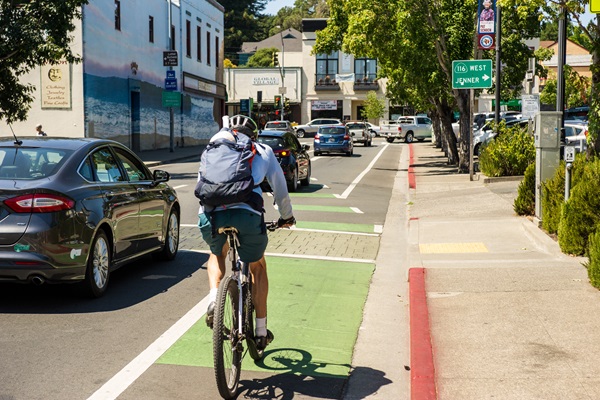
Safety has continued to be a major focus of the department, with this 2020-completed bike lane in Sebastopol representing not just a safety issue but also an example of how Caltrans is promoting alternative forms of transit.
Caltrans Headquarters photo
![]()
It’s been a bumpy year so far for potholes
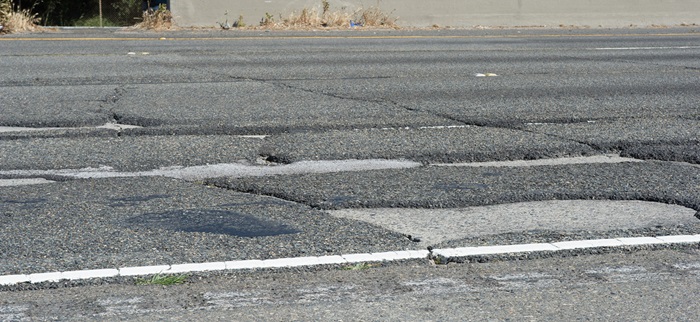 Roadway pavement can become a patchwork of repairs after succumbing to potholes, whose presence markedly increased statewide following a steady parade of winter storms.
Roadway pavement can become a patchwork of repairs after succumbing to potholes, whose presence markedly increased statewide following a steady parade of winter storms.Caltrans Headquarters photograph
A steady succession of winter storms battered the state and wreaked havoc with roadways’ pavement
On March 15, sometimes referred to as the Ides of March, California had a bit of a pothole problem, and Caltrans crews were tasked to be the problem-solvers.
Atmospheric river after atmospheric river had been pouring over the state for months, and there were roadway pavements of asphalt and concrete that simply could not take it anymore. Not only were there tire-targeting potholes, but there also were flooded roads, fallen trees blocking roads and – on chronically elements-battered State Route 96 near Happy Camp – a massive rockslide completely and still actively burying that rural road.
Lots of challenges for lots of transportation officials and workers, but this story will focus on the smaller ones. The “quick fixes.”
The potholes.
Those pesky voids, which on concrete surfaces are called spalls, have no shortage of places to wreak traffic havoc on Caltrans-overseen roadways. Consider how extensive those roadways are: According to the Division of Maintenance’s Customer Service Request (CSR) webpage where residents can formally report the presence of potholes or other roadway issues, Caltrans owns or controls 15,133 centerline miles of highway in California.
Caltrans told NBC Bay Area in mid-February that the department receives about 1,000 pothole damage claims annually, but by that point in 2023 there already had been 459 such claims filed. Those claims stemmed from the more than 44,000 potholes that Caltrans had recorded in January and early February, a number that is about half the annual average.
In late March, the parade of media inquiries about potholes had been so relentless that Caltrans public information officers were told to use the following statement, as appropriate:
“Caltrans is aware of recent media coverage of the storms and resulting damage, including information on how to submit claims to Caltrans for vehicle damage caused by potholes and/or debris on our state highways.
“Some media coverage incorrectly suggests that Caltrans administers a reimbursement program for vehicle damage. Under California law, Caltrans does not insure vehicles for damage on our highways.
“Drivers in California must exercise caution on all roads and carry adequate automobile insurance to cover liability and property damage. However, in limited circumstances, Caltrans may be statutorily responsible for damage to a vehicle.
“Drivers on our state highways who believe Caltrans is responsible for damage to their vehicles can learn more about filing a claim on this Caltrans webpage. Caltrans evaluates claims for sufficiency and decides whether to reject, accept, or deny such claims.”
From July 1, 2022, through June 30 of this year, Caltrans crews patched 157,959 potholes and spalls, which represented 190,529 worker hours and cost more than $17.6 million.

Earlier this year on the District 7 Twitter page, Caltrans was able to chronicle how a pothole-plagued roadway was patched up.
District 7 tweet
To obtain a better understanding about how Caltrans repairs potholes and spalls, Mile Marker reached out to Angelo Gross, office chief for Maintenance support in District 3.
Obviously, Caltrans must know about the potholes before they can be repaired. Gross said the department learns about their presence in several ways, including through external customer service requests (CSRs) and Maintenance rupervisors' territory and asset assessments at least once a week to take note of any deficiencies (and from area superintendents, who make the rounds at least once a month), and through the California Highway Patrol (CHP), which communicates with Caltrans via the district transportation management centers (TMCs).
How soon after being told there is a pothole does Caltrans have to fix it? Gross said the department does understandably require sufficient time to prepare and to respond.
“Anything that’s a safety-related issue, we need to address immediately,” Gross said. “But the key thing is being aware in order to be able to provide an adequate and timely response.
“Before we put in a full response, we need to assess the area. See where it’s at. Is it safe to go out there and have the crews take care of it? Is it going to need a lane closure? Is it going to need a traffic break?
“And so, for example, if you’re talking somewhere in a rural area on State Route 45 in Yolo County, well you might get one car an hour out there, so it may not be that big of a deal that you must put in a full lane closure. You may be able to take care of the pothole with a traffic break and shadow truck. But if you’re talking somewhere on Cap City Freeway (also known as Business Interstate 80, in Sacramento), even on the shoulder you’re going to need some kind of traffic control, and something put in so you can safely get the work done.”
The latest Caltrans Maintenance Manual Volume 1 provides crew members with standard pothole repair basics. First, remove all loose material prior to patching them. Grade the area evenly with sloping sides to the depth of the patch. The bottom and sides should be primed. For priming, use either a liquid asphalt or emulsion. Pre-mixed material is then applied. Place it in cold and compact it. Make allowance for compaction that will permit the finished surface of the patch to be just slightly above the surrounding surface. And so on.
Gross said that a bag of premix runs anywhere from $15 to $40, with the more-expensive bags helpful in inclement weather situations.
“The main thing is getting the pothole clean,” he said. “Removing anything loose in there. Depending on traffic and the environment, you want to get it to where you get all the loose material out.” A properly patched pothole has to have “something solid to bind on.”
Generally, there’s no wait time required between pothole fix and people being able to drive over it.
Back on March 15, the presence of potholes was mentioned in newscasts up and down the state. A Caltrans spokesperson who was interviewed on Spectrum News 1 in Los Angeles referred to “a multitude of potholes,” adding that “potholes are being repaired in a multitude of areas.” A KNBC journalist reported live in Pacoima, where on State Route 71 some 30 vehicles had sustained flat tires and Caltrans crews were going through literally truckloads of repair materials trying to prevent more flat tires from happening. Bay Area reporters were populating the airwaves with similar tales.
This year’s Ides of March weren’t Julius Caesar-bad, but they certainly put Caltrans to the test.
Source: Angelo Gross, office chief for District 3 Maintenance support
![]()
Clean California gives local agencies a beautification boost
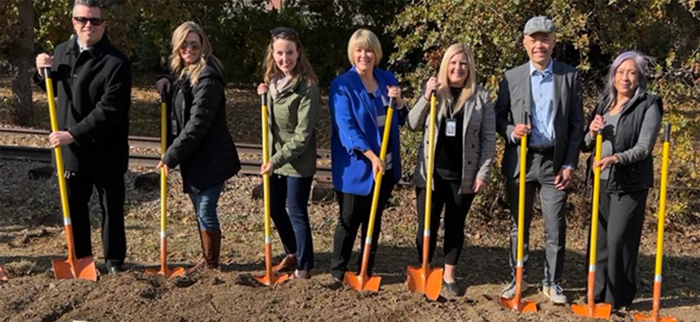
District 3 photograph
In its first cycle, the Clean California Local Grant Program awarded about $300 million statewide
The Clean California initiative is a multifaceted push to improve not just aesthetics but also the lives of those who reside in or visit the 58 counties within our Golden State.
One of the initiative’s vital components is the Clean California Local Grant Program (CCLGP) managed by Caltrans Division of Local Assistance. The program, which in its first cycle last year awarded approximately $300 million to 105 local agencies, is helping communities beautify and improve streets, tribal lands, parks, pathways and transit centers.
Cycle 2 of the program, which will provide approximately $100 million in grant funding to local communities, accepted applications through April.
The program’s four goals are:
- Reduce the amount of waste and debris within public rights-of-way, pathways, parks, transit centers, and other public spaces.
- Enhance, rehabilitate, restore, or install measures to beautify and improve public spaces and mitigate the urban heat island effect.
- Enhance public health, cultural connection, and community placemaking by improving public spaces for walking and recreation.
- Advance equity for underserved communities.
Caltrans lists and briefly describes the Cycle 1 grant recipients online. Local projects were provided grant awards, ranging in size from the maximum $5 million all the way down to several whose total project cost is less than $1 million. There is no minimum grant amount request for this program.
One example is the Hoopa Four Project, whose entire $5 million cost is covered by a Clean California grant. The District 1 project will provide debris removal, beautification, rehabilitation and enhancement to community parks and spaces for ADA accessibility for rolling, walking and recreation. Pookey’s Park, Hoopa Rodeo Grounds, Tish-Tang Campground and Neighborhood Facilities are among the sites scheduled for improvements.
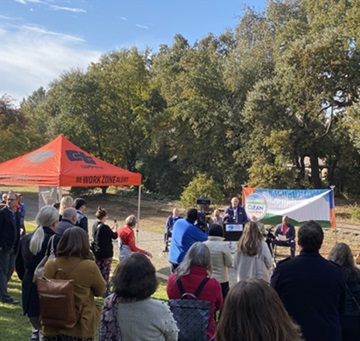
The Del Rio Trail through an inner-city neighborhood promises to benefit bicyclists, runners, dog-walkers and other outdoor enthusiasts.
District 3 photograph
Pookey’s Park, opened in 1977, encompasses 11.5 acres and serves as a quasi-extension of school playgrounds and is regularly utilized by nearby schools. The Rodeo Grounds and TishTang Campground are similarly sized and in need of modernization. The Neighborhood Facilities is a 6.2-acre parcel of lands encompassing the Hoopa tribal administrative and recreation departments.
This small but transformative project will increase the availability of public spaces to the underserved community of the North State town.
Also among the $5 million grantees was the city of Sacramento, for its $16.7 million Del Rio Trail project. The proposed 4.8-mile trail will run south through the Land Park, South Land Park, Freeport Manor, Z’Berg, Pocket, and Meadowview neighborhoods between Interstate 5 and Freeport Boulevard.
A Sacramento city webpage describes the project as "an inner-city trail that will allow cyclists, pedestrians, runners, and dog walkers to travel for miles to access schools, parks, retail centers, and jobs. It provides the potential for recreation amenities and will serve as an alternative commute route for people to bike to work rather than drive on freeways and boulevards.”
The project will contain 10 public art works and plant some 810 trees. A groundbreaking ceremony was conducted last autumn and a short video summary of the event is posted on YouTube. From the groundbreaking event, it was clear that the community is excited about this project and its potential to benefit underserved communities, just like the Quincy Pocket Park project.
For Cycle 2 of the CCLGP, Caltrans has refined the project selection criteria to further support:
- Community need
- Potential to enhance and beautify public space
- Potential for greening to provide shade, reduction of the urban heat island effect, and use of native drought-tolerant plants
- Potential to improve access to public space
- Public engagement in the project proposal that reflects community priorities
- Benefit to underserved communities
Awards are to be announced late this summer, and projects are to be completed by June 30, 2026.
Required local match funds are based on the level of disadvantage in the community surrounding the project location(s) and can range from zero to 50 percent of total grant amount request. The required local match will decrease as the disadvantage of the community increases.
Also in Cycle 2, eligible project sites must be partially or fully located in an underserved community, and at least 75 percent of the population surrounding the project site(s) must be underserved.
For more information on the program, including upcoming workshops on how to complete the application, visit this Clean California webpage.
Source: Gretchen Chavez, chief of the Office of Innovative Programs, Division of Local Assistance
![]()
Project spotlight: Final-touches time for Sacramento’s ‘FixSac5’
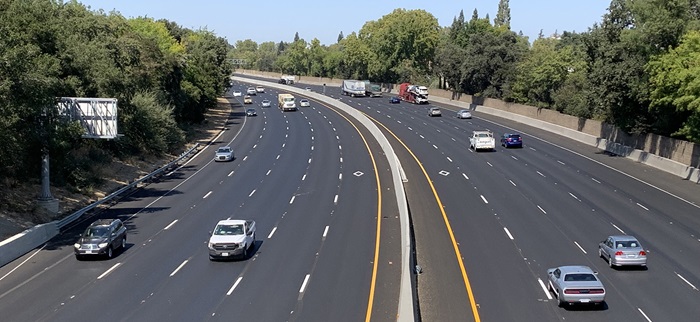
District 3 photograph
Capital commuters, others benefit from $370 million Interstate 5 Corridor Enhancement Project
Anyone who resides in the Sacramento metropolitan area or has driven through it at any point during the past four years likely has encountered the $370 million Interstate 5 (I-5) Corridor Enhancement Project.
Launched in 2019 to rehabilitate pavement, construct new carpool lanes, replace a pedestrian overcrossing, construct sound walls, install new fiber optic lines, add ramp meters and extend various entrance and exit ramps, the “FixSac5” project is nearing completion. (This spring, work still required occasional overnight closures of some ramps and connectors; the latest updates are posted on the FixSac5.com website.)
The smooth pavement alone has made a profoundly positive difference for all motorists on the roughly 15-mile stretch of I-5 from a bit south of Elk Grove Boulevard on up to Discovery Park, where the freeway crosses the American River. All told, the project repairs 67 lane miles and constructs 23 miles of High Occupancy Vehicle (HOV), or carpool lanes.
Beyond the material updates and additions FixSac5 has accomplished, it also seeks to:
- Improve traffic operations by reducing congestion and travel time.
- Provide more reliable peak travel times.
- Provide travel time incentives for commuters to use carpools, van pools or buses in peak travel periods.
- Improve air quality by promoting carpool and vanpool.
By the mid-2010s it was clear that this portion of Interstate 5 needed attention. The pavement had deteriorated to the point where it was blotched with pothole and crack repairs and provided what Caltrans deems to be poor ride quality.
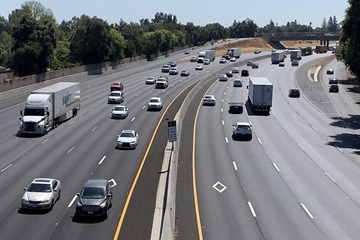
The multiyear project has made a big difference in terms of pavement smoothness, and has added several other features that include carpool lanes.
District 3 photograph
The new HOV lanes were needed because the corridor was experiencing recurring congestion during peak commute periods. Traffic demand during commute periods exceeded the freeway capacity, and the amount and duration of congestion is expected to increase in the future as suburban development in portions of the city of Sacramento and the City of Elk Grove increase.
Three-quarters ($280 million) of the project’s total cost was funded by the State Highway Operation and Protection Program, Senate Bill 1 of 2017, the Road Repair and Accountability Act, provided $48.3 million; the Sacramento Transportation Authority Local Measure A tax contributed $33.2 million; and the Sacramento Area Council of Government's Congestion Management and Air Quality Improvement Program accounted for $8.5 million.
Caltrans’ top priority throughout the four-year construction, of course, has been safety – for both road crews and the motoring public. Work zones have typically been marked by signs, cones, barrels, channeling devices, barriers, pavement markings and/or work vehicles. Lower speed limits were posted and enforced.
During the most work-intensive portions of the project, in the first couple of years, motorists and truckers were strongly encouraged to use State Highway 99 as an alternate route to Interstate 5. Caltrans also has encouraged people to use public transportation, share rides, walk or bike to reach their destinations.
Among the project’s many milestones was when the old pedestrian and bike overcrossing at Casilada Way – between the Sutterville Road and Seamas Avenue exits – was demolished in February 2021 to make way for the new, Americans with Disabilities Act (ADA)-compliant overcrossing. The new Casilada Pedestrian Overcrossing was completed and opened to the public in April 2022.
Some of the project’s many other milestones have included the fortification of a sound wall south of Pocket Road and Meadowview Road; bridge work north of Laguna Boulevard, north of Cosumnes River Boulevard and north of Casilada Way; median widening work at Laguna Boulevard to north of Laguna Boulevard; and asphalt work from Florin Road to the I-5 interchange with U.S. Highway 50, which included 55-hour weekend closures.
One challenge that Caltrans has encountered is the electrical work lagging behind in the project schedule. To help with moving the electrical work forward and resolve issues in a timely manner, a weekly electrical meeting among the contractor, construction office and electrical group is held to discuss schedule, RFIs (requests for information) and any electrical issues.
Additionally, field meetings with both the contractor and electrical group investigating the issues together have provided faster solutions. All parties have the partnering mindset to complete the electrical work within the remaining project schedule.
Another challenge on this project was traffic closure conflicts with other construction projects working in our same area. Initially, conference calls were held with the contractors and District 3 Transportation Management Center to coordinate the closures. Caltrans asked the contractors to coordinate among themselves two weeks ahead of time, which resulted in fewer traffic closure conflicts.
Caltrans has remained within budget for all work proposed on the project. The roadway rehabilitation work is complete, and the HOV lanes are in operation, which officially was open to the public on Oct. 24, 2022. As of Mile Marker publication, Caltrans is fine-tuning some minor construction items to be ready for project acceptance.
Source: Dennis Keaton, District 3 information officer; Erin Mock, assistant resident engineer
![]()
District 11 looks to turn the corner on wrong-way crashes
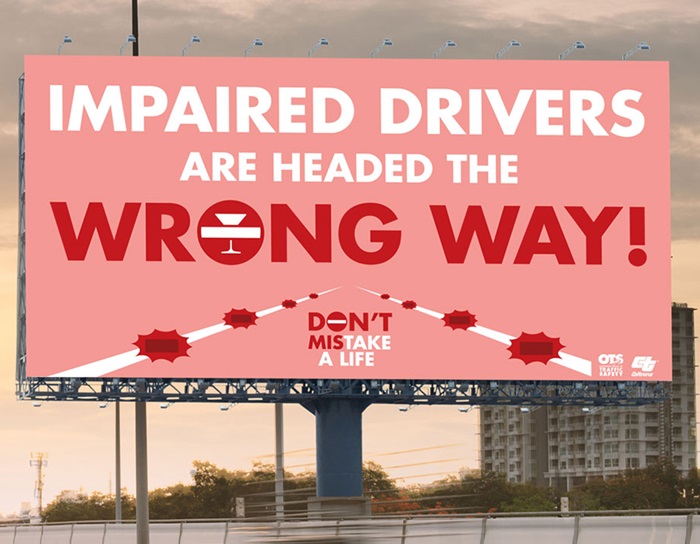
District 11 photograph
Caltrans and the Office of Traffic Safety team up to address a flurry of such incidents in San Diego
There are few roadway scenarios as terrifying as two vehicles speeding directly toward each other and colliding head-on. The results are often catastrophic.
Perhaps the only positive thing to say about wrong-way crashes is they represent a very small percentage of highway collisions – less than one-tenth of one percent. Caltrans and its travel-safety partners are striving to further decrease the frequency of wrong-way crashes, and ideally eliminate them altogether.
In May 2022, Caltrans and the California Office of Traffic Safety (OTS) launched a wrong-way driver education and prevention campaign in San Diego County to reduce incidents of drivers entering the freeway in the wrong direction and encourage drivers not to drive impaired.
In recent years, the District 11 region has sustained a grim succession of wrong-way collisions that have been widely covered in the media and prompted calls for greater safety measures. Statewide, according to the latest available statistics, an average of 37 people die each year in wrong-way crashes. In 2019, there were 248 wrong-way crashes on California's state highways. Many of the involved drivers were under the influence of drugs or alcohol.
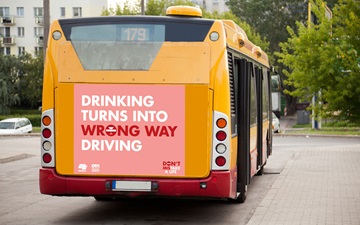
The safety campaign’s marketing reach has extended to public buses and many other canvases seen by those traveling in and around San Diego.
District 11 photographNationally, there were about 500 deaths per year from wrong-way driving crashes from 2015 to 2018, up 34 percent from the deaths in 2010 to 2014, according to research performed by the AAA Foundation for Traffic Safety.
Since the 1960s, Caltrans has been installing "WRONG WAY" and "DO NOT ENTER" signs at exit ramps and painting large, one-way arrows on the exit-ramp pavement. Recently, the department has installed reflectors that appear red to wrong-way drivers on freeway lanes and exit ramps.
Since 1985, Caltrans has had a robust monitoring program to investigate wrong-way driving incidents. The department uses collision data to identify problem locations and sends teams of engineers out to review the location and recommend solutions. These teams of engineers determine if simple fixes are in order, such as more signs, markings, and lighting. In some cases, Caltrans might even change the alignment of exit ramps and roadways.
In 2017, Caltrans conducted a pilot program in San Diego and Sacramento in which it installed specialized red reflective on the back side of pavement markers, detection systems and illuminated signs. The number of wrong-way drivers decreased by 44 to 64 percent during the pilot program depending on the type of enhancement.
The reflective markers proved to be so effective that Caltrans made them part of the current standards for exit ramps in California and has installed them on many exit ramps throughout the state, including almost 700 in District 11 as of this summer. Caltrans has allocated nearly $9 million toward wrong-way driver prevention upgrades such as red pavement reflectors and larger wrong-way warning signs.
As part of efforts to prevent wrong-way driving launched in 2022, District 11 worked through a Director's Order to upgrade and expand wrong-way driver infrastructure for more than 90 exit ramps on various routes in San Diego County that have experienced wrong-way driving events.
The driving public may not see the innovative technology Caltrans crews are installing since much of the infrastructure, like the red reflectors on the pavement and the flashing “DO NOT ENTER/WRONG WAY” signs, are only meant to be seen when driving the wrong way.
Most of the installations were performed overnight or on weekends, when traffic was projected to be at its lightest, and efforts were made to minimize the public impacts.
Caltrans will continue to monitor and evaluate the newly installed enhancements. Signage and red reflective markers, however bright, blinking and omnipresent they are, will not alone eliminate wrong-way driving. Motorists have to be educated about the danger of driving under the influence and respect the perils that wrong-way driving poses. With that in mind, Caltrans has teamed with organizations that include the California Highway Patrol (CHP), Mothers Against Drunk Drivers (MADD), and the OTS to develop a public campaign effort.
The campaign featured the tagline "DON'T MISTAKE A LIFE" to remind people not to make a mistake and end up taking someone's life by entering the freeway in the wrong direction. The campaign also features headlines such as "RED REFLECTORS MEAN WRONG WAY" and "IMPAIRED DRIVERS MAKE WRONG WAY DRIVERS" to bring context to the message. The campaign includes billboards, social media, advertising on buses, print advertising and transit shelters.
Here are some wrong-way-wary practices to observe when you are driving:
- If you see a wrong-way driver, move as quickly and as safely out of the way as possible. As soon as it is safe to do so, call 911 and report the driver.
- Maintain a high visual horizon to scan the environment on the road far ahead of where you are driving. This increases your ability to see roadway hazards far ahead and safely get out of the way.
- Most importantly, avoid distractions, pay attention, and don't drive while impaired.
Source: Stephen Welborn, District 11 information officer
![]()
Caltrans looks to lead the way to an electrified future
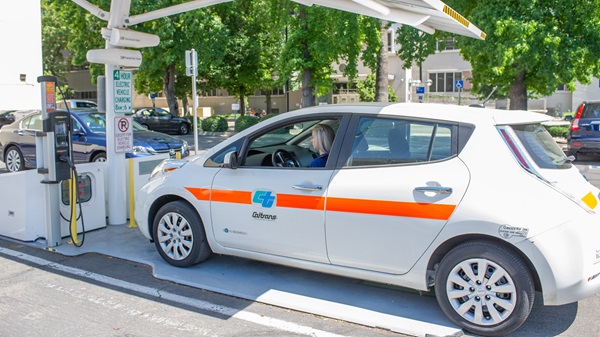
Headquarters photograph
Spurred by governor’s orders, climate change and air pollution, department embraces zero-emission vehicles
The evolution of what powers transportation is – no doubt about it – electrifying. Caltrans is busy making plans for and implementing changes that are transforming how people and goods make their way about the Golden State.
The era of ZEV (zero-emission vehicles) is upon us.
Through executive orders issued in 2018 and 2020, Governors Edmund G. Brown Jr. and Gavin Newsom decreed that the following goals be pursued and met:
- By 2025, there will be 250,000 electric vehicles chargers in California.
- By 2030, there will be 5 million ZEVs on California's roads.
- By 2035, all new passenger cars and light-duty trucks sold in California will be ZEVs and 100 percent of off-road vehicles and equipment will be ZEVs.
- By 2045, 100 percent of medium- and heavy- duty vehicles in the state will be zero-emission, where feasible.
Since then, the state has enacted policies setting these goals into law.
In May, Caltrans Director Tony Tavares reinforced the department’s commitment to making this electrifying change happen.
“California is at the forefront of policies that encourage the adoption of ZEVs, support the maturation of the industry, improve access, and ensure communities most impacted by vehicle pollution benefit,” Tavares said in a department-wide email.
“As we all know, the economy relies on mobility, and the future of mobility is emission-free, whether e-bike, transit bus, or semi-truck. Fortunately, we are already seeing significant progress in California.”
"California is at the forefront of policies that encourage the adoption of ZEVs, support the maturation of the industry, improve access, and ensure communities most impacted by vehicle pollution benefit."
Mile Marker recently asked Jimmy O’Dea of the Director’s Office of Equity, Sustainability & Tribal Affairs to discuss what Caltrans is doing to pave the way for an all-ZEV future.
He began with a clarification.
“When we say electric vehicle, we mean both battery and hydrogen fuel cell vehicles,” O’Dea explained. “Some people interpret electrification as only batteries, but the technology of a hydrogen fuel cell vehicle also uses an electric drive train powered by electricity, once the chemical energy in hydrogen is converted to electrical energy by the fuel cell.”
Then O’Dea launched into the big picture.
“Of the four big buckets of our work, one is our own fleet. We have 11,000 vehicles ranging from sedans to snowplows, and we want to electrify them all over time. In the words of Division of Equipment lead Bob Meyers, we want to be the ‘greenest fleet in the country.’
“Some vehicles are easier to electrify than others and we’re making progress on the low-hanging fruit already. Over the last year, we’ve added roughly 400 electric sedans to our fleet. We’ll begin getting electric SUVs this year. We have several hundred electric pickup trucks on order that we’re also hopeful to begin taking deliveries of soon. So, we’re starting to make progress on our fleet and we want to be a leader in this area not only for other state DOTs but also large, private fleets of similar size. We’re among the largest transportation fleets in the country, and electrifying our fleet is a really exciting opportunity.
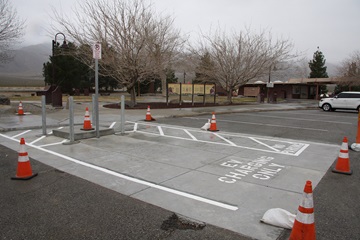
Charging infrastructure is under development across the state, as this 2020 photo of the Coso Junction rest area along U.S. Highway 395 illustrates.
Caltrans Headquarters photograph
“The second big bucket is supporting charging for the public. This is done largely through funding programs that we’re administering, or with funding that we’re seeking on behalf of the state. A big program that we’re helping to administer is the National Electric Vehicle Infrastructure Program, a formula-funded program that is part of the Bipartisan Infrastructure Law and provides funding to all states to invest in charging infrastructure for long-distance intercity and interstate travel.
“We’re working with the California Energy Commission, which is the national expert in delivering charging infrastructure grant funding, to get this program out the door. This program is going to support charging on over 6,000 miles of California interstates and highways. With this funding, there will be at least four fast chargers every 50 miles on these corridors, and in many cases a lot more. …
“So it’s a $384 million project [$5 billion nationally] that we’re really excited about, and hope to formally kick off with release of the funding this year.
“There’s also $2.5 billion in discretionary funding that we’re interested in bringing to the state from the federal infrastructure bill. We worked with the California Energy Commission, Oregon Department of Transportation, and Washington State Department of Transportation to develop a proposal to support truck charging and hydrogen fueling along I-5 and major freight corridors from Mexico to Canada.
“The next big bucket is our rail and transit effort. From the rail side, we provide locomotives for three intercity corridors, the Capital Corridor, San Joaquin and Pacific Surfliner rail lines. We’re committed to transition those rail fleets to zero-emission technology. Our rail team is in the exploratory stage right now, working with potential manufacturers on vehicle specifications and to take our goals from paper to practice. Rail will also be an area where Caltrans can emerge as a national leader, as we transition these vehicles to zero-emission technologies.
“On the transit side, we’re one of the largest funders of zero-emission bus efforts through both state and federal funding that we direct to transit agencies. Transit agencies have state requirements for transitioning their fleets to zero-emission buses, so we’re very interested in providing as much support as we can to achieve these standards, which are beginning to take effect this year.
“The last big bucket is our freight work. And here, again, we’re trying to support the freight industry’s transition to zero-emission technologies, namely by supporting charging and hydrogen fueling infrastructure along truck corridors. We’ve been both an applicant for state funding for these types of projects, and we’re also the administrator of programs that can potentially fund these types of programs. Given the funding that’s available, our position as technical leaders in the freight industry, and our relationships across private and public stakeholders in the freight industry, I expect us to play a large role in support freight’s transition to zero-emission technologies.”
There will be at least four fast chargers every 50 miles on these corridors, and in many cases a lot more.
Does O’Dea see anything in particular being especially difficult, or challenging, to overcome?
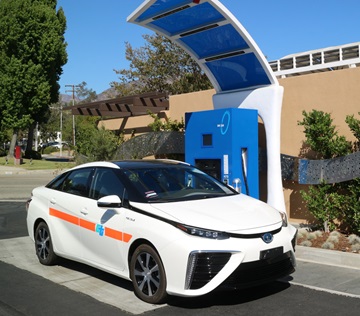
Caltrans passenger-size cars represent the department's most-straightforward vehicles that run entirely on electrical or hydrogen power.
Caltrans Headquarters photograph
“A theme through all of these efforts is change. The further you are on the leading edge, the more barriers and challenges you’ll encounter. We want to be on the leading edge and are comfortable facing these new challenges.
“So of those (four main “buckets”), none, I would say, is any more challenging than the others. The lessons we’re learning in transitioning our own fleet to electric technologies are similar to what private fleets are experiencing with their vehicles and operations. Some of our vehicles, such as our snow plows, operate on as strenuous of duty cycles as any vehicle out there.
“Public charging – we want to deliver a really good product to the public, which means chargers that are reliable, which hasn’t been the case to date for all companies. There’s a spectrum of reliability in the market right now. We hope to solve that with reliability requirements for funding we administer.”
Are there political forces at play in terms of what individual states do to bring about a national ZEV landscape?
“Before the infrastructure bill,” O’Dea responded, “there were tax credits for passenger electric vehicle purchases and tax credits for charger installations at the federal level. In California we’ve had hundreds of millions of dollars in projects for vehicle incentives both on the passenger side and the commercial side. The California Public Utilities Commission has also adopted landmark policies to bring the investor-owned utilities into the mix.
“It's very encouraging and exciting, the federal funding that is available right now. It is bringing in states that haven’t been as committed to electrification as California and that’s a great thing. California has been driving the market for several years and it’s going to be great to have investments across the country that will ultimately benefit us with economies of scale and lessons learned from more people, more companies, and more states in the mix.
“There’s been some really great interstate planning, particularly on the West Coast, that’s been going on for over a decade that is starting to bear fruit with charging for cars along Interstate 5 in Washington, Oregon, and California. The next step is to build out that infrastructure for trucks.”
Learn more about Caltrans’ ZEV efforts on this Sustainability Office webpage. Find updates on statewide ZEV progress via this California Energy Commission site.
Source: Jimmy O’Dea, Assistant Deputy Director of Transportation Electrification in the Director’s Office of Equity, Sustainability & Tribal Affairs
![]()
Senate Bill 1 efficiencies program sets new records in 2021-22Senate Bill 1 efficiencies program sets new records in 2021-22
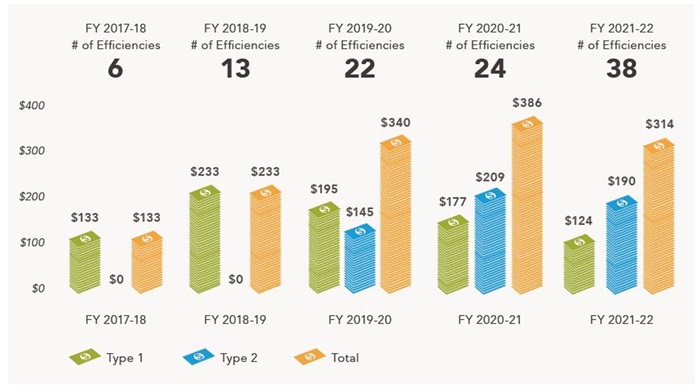
SB 1 Efficiencies Program graphic
Caltrans is required to achieve at least $100 million in cost-savings each year to invest back in highway system
One of the guiding principles of good governance is spending taxpayer money wisely and with limited waste. Caltrans demonstrates its commitment to that principle with the Senate Bill 1 (SB 1) Efficiencies Program.
As mandated by SB 1, the Road Repair and Accountability Act of 2017, Caltrans is required to achieve at least $100 million in efficiencies each year to invest back in the maintenance and rehabilitation of the state highway system. In fiscal year 2021-22, the department set record highs for the number of new efficiencies (14) and total number of efficiencies (38).
Those efficiencies added up to $124 million, or 24 percent more than is required by SB 1.
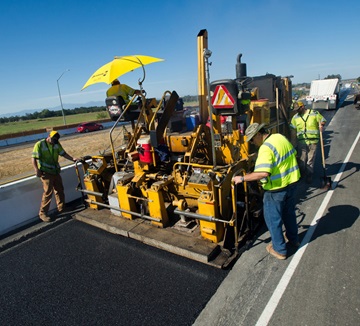
Due to Caltrans and its partners streamlining procedures for the Job Mix Formula (JMF) renewal process, annual savings of $8 million are anticipated.
Division of Maintenance photograph
Although every efficiency is achieved through teamwork – a collaboration of people with innovative ideas, expertise, persistence, support and funding, among other qualities and factors – sometimes there is good reason to shine the spotlight on an individual employee’s contributions. Such is the case with Allen Cripe, lead heavy equipment body worker/painter in the Division of Equipment (DOE).
The DOE purchases, fabricates, maintains and repairs Caltrans’ fleet equipment, which is composed of more than 12,000 pieces of equipment. The division employs about 730 workers, including more than 400 heavy equipment mechanics around the state who maintain and repair equipment, and a Headquarters staff that includes Cripe.
As part of the paint preparation process for vehicles, the DOE must prepare several items by sanding and grinding steel parts. The amount of time, effort and cost to produce finished quality parts for the production line represented a challenge that Cripe wanted to address. Each piece required mechanical grinding and sanding to remove mill scale and sharp edges before sending to the paint booth. Getting into the small corners to produce a smooth finish was difficult with a 6-inch orbital sander.
The potential for employee injury due to the constant vibration from the hand sanders over a prolonged window of time was a concern, as well as handling parts that were not smooth or finished in the interior areas. Mechanics on the assembly line were at increased risk of hands getting injured or cut.
About a decade ago, Cripe began to research options on his own after work hours. He researched vendors that manufacture equipment to improve the paint preparation process. He contacted steel shot manufacturers across the United States to get a competitive bid.
Eventually, Cripe came upon L.S. Industry in Wichita, Kansas, which manufactures custom pieces of equipment to produce finished “shot” (smooth/sanded) material parts. This vendor had a solid reputation and offered a warranty that would protect the DOE.
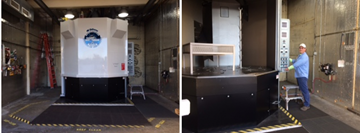
"Slingshot Suzie," pictured closed and open, has pretty much paid for herself over the years since Allen Cripe, right, spearheaded her arrival at the main Caltrans equipment yard in Sacramento.
Division of Maintenance photographs
After Cripe creatively addressed a potentially costly side issue involving the machine’s ventilation system, in 2015 he received his supervisors’ approval to order the new equipment.
Cripe worked closely with the vendor determining the turn table size, drive motors’ power and the interior liner of the blast cabinet. In 2016 he flew to Kansas to inspect and test the efficacy and efficiency of the equipment and approve the final process of the purchase. The equipment arrived in Sacramento that July.
“Slingshot Suzie,” so named by Cripe because “shot” is the material that is used to spin around the interior creating smooth finishes, is housed in Headquarters’ production yard. Suzie’s life expectancy is 40 years, which is projected to save Caltrans $53,950 per year, or $2,158,000 through the year 2056. Having cost $271,195 seven years ago, Suzie by now has paid for “herself.”
Another example of a big money-saver reflected in the 2021-22 Efficiencies Report is the Cone Penetration Test (CPT) technology that Caltrans used extensively on the Interstate 405 project in Orange County. The project has a budget that tops $2 billion. It is listed as the largest state roadway project currently under construction, rebuilding what many consider to be the country’s busiest freeway.
CPT technology allowed Caltrans to define the project’s geotechnical site characteristics. Thirty bridge structures are either being replaced or newly constructed along a 16-mile-long stretch of highway, and through the use of CPT no soil samples were needed to determine the geotechnical engineering properties of soils, delineating soil stratigraphy and characterizing subsurface conditions.
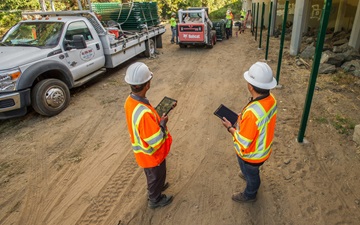
In the 2021-22 fiscal year, the Division of Construction distributed 400 tablets to its field workers, bringing the total to 1,700 and resulting in $3.08 million in savings for the 12-month period.
Division of Construction photograph
Caltrans credits CPT with shaving a bit more than $7 million from this mega road-rehabilitation project in District 12 (San Diego County).
“It is vital for our executive staff to continue to engage with and encourage everyone to contribute to the efficiencies effort, and it’s important to recognize and appreciate individuals to maintain success,” said SB 1 Program Manager Angel Pyle. “We are very grateful for the contributions made to help Caltrans reach its $100 million SB 1 goal each year. We’re all responsible for reaching our goals each year.”
Here are some of the other noteworthy efficiencies that Caltrans chalked up in the 2021-22 fiscal year:
- Most dollars saved – Division of Design
- Most efficiencies ideas submitted – Division of Procurement & Contracts
- Most approved efficiencies - Division of Environmental Analysis
- Most new efficiencies – Division of Engineering Services
- Most dollars saved through district submissions – North Region
As of this writing, Caltrans was collecting information about efficiencies to include in the program’s report for fiscal year 2022-23. Early indications are that Caltrans will again exceed $100 million in savings and the fiscal year 2022-23 report is expected to be published in late fall of 2023.
Source: Patrick Olsen, SB 1 efficiencies manager
![]()
HSIP grants help local agencies improve safety

Caltrans District 9 photograph
282 projects totaling $225.6 million have been approved for funding as part of Cycle 11 of the program
In March, the Division of Safety Programs announced that 282 projects have been approved for funding as part of Cycle 11 of the Highway Safety Improvement Program (HSIP). All 12 of Caltrans’ regional districts are represented in the latest HSIP cycle, whose projects total $225.6 million.
HSIP is a core federal-aid program with the purpose to achieve a significant reduction in traffic fatalities and serious injuries on all public roads. State funds are used for many of the Cycle 11 projects.
Two years ago, in HSIP Cycle 10, 154 local agencies were selected to receive their shares of the $226.7 million that was awarded.
Following are the largest HSIP Cycle 11 funding awards in each district.
District 1, where 16 projects were awarded HSIP funds: At various locations in Mendocino County, install advance curve warning signs, sidewalks and pathways, and installation/upgrade of pedestrian crossing on roadways and ramps. $2,578,140 in HSIP funding ($2,864,600 total project cost).
District 2, one HSIP project: In Lassen County, install edge rumble strips, centerline rumble strips and high friction surface treatment along length of corridor and advance curve warning and chevrons signs at two curves on Lassen Center Road. $291,150 ($323,500).
District 3, 29 HSIP projects: At various locations in Yuba County, install/upgrade signs with new fluorescent sheeting (regulatory or warning). $4,003,200 ($4,448,000).
District 4, 60 HSIP projects: In Concord, install new street lighting, upgrade existing street and intersection lighting, install pedestrian countdown signal heads, and modify phasing to provide a Leading Pedestrian Interval (LPI), among other safety improvements $7,409,970 ($8,233,300).
District 5, 17 HSIP projects: On San Juan Grade Road in Monterey County, install sidewalks and streetlights, and install radar feedback signs at the road transitions from a rural highway to an urban arterial. $1,344,690 ($1,494,100)
District 6, 32 HSIP projects: At various locations in Tulare County, upgrade existing, damaged, outdated, and destroyed guardrail to current standards. $936,540 ($1,040,600)
District 7, 53 HSIP projects: At various rural locations in Ventura County, install edgeline and/or centerline rumble strips and/or curve warning signs, on mid-block segments of county-=maintained roadways. $6,039,810 ($6,710,900)
District 8, 43 HSIP projects: In Riverside, install retro-reflective signal backplates, implement Leading Pedestrian Interval (LPI) timing at all signals citywide, and construct a raised median along Mission Inn Avenue from Redwood Drive to Scout Lane. $7,815,420 ($9,018,200)
District 9, one HSIP project: On a 1.2-mile stretch of Old Spanish Trail Highway in the Emigrant Pass area, install high-friction surface treatment, curve warning signs and flashing beacons. $188,640 ($209,600)
District 10, 13 HSIP projects: In Stockton, install a Leading Pedestrian Interval, high visibility crosswalk, left-turn phasing, curb extensions, raised median, curb ramps, and left turn lanes at Lorraine Avenue and Hammer Lane, Wilson Way and Park Street, and Wilson Way and Waterloo Road. $2,589,480 ($2,877,200)
District 11, 9 HSIP projects: In Escondido, improve signal hardware including lenses, back plates with retroreflective borders, mounting and number; install pedestrian countdown signal heads; and modify the signal phasing to implement a Leading Pedestrian Interval. $1,326,240 ($1,473,600)
District 12, 10 HSIP projects: Throughout Costa Mesa, install retroreflective backplates and upgrade 8-inch signal heads to 12-inch, implement Leading Pedestrian Intervals, install countdown pedestrian signal heads, install emergency vehicle preemption systems, and install battery backup systems. $3,906,090 ($4,340,100)
Source: Division of Safety Programs
![]()
The roads not traveled – until further notice
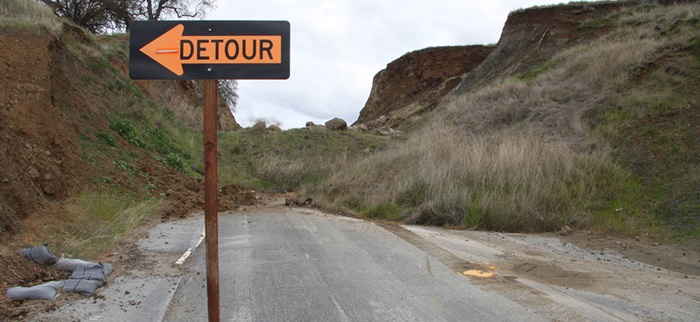
Caltrans Headquarters photograph
Mile Marker presents three examples of long-term roadway closures that Caltrans has been addressing for quite some time
Roadways can be closed every now and then due to something invading from above, beside, or below – be it snow or rain, rocks, dirt or a combination of objects that somehow compromise a safe driving surface.
Usually, Caltrans Maintenance crews can clear off the roads or quickly patch them up. When there is foundational or structural damage, Construction and possibly other departmental divisions become involved.
Rarely, a highway closure rises to the catastrophic level, causing loss of life and/or being profoundly disruptive to traffic flow. The collapse of a portion of the San Francisco-Oakland Bay Bridge in October 1989 and the coast-side washout of State Route 1 at Rat Creek in January 2021 are two examples. In those and other such cases, the state employs emergency measures to reopen the roadways as soon as possible, with speed being the top priority while cost – still very important and closely monitored – is a subordinate concern.
Occasionally, portions of highways are blocked off due to damage that cannot be quickly repaired, and the closures do not pose major disruptions to the needs of commerce, tourism, or local navigation. So, their re-openings can take a while – years, even – as Caltrans and other involved parties weigh the environmental and cost impacts and formulate the engineering.
Following are three examples of long-term roadway closures that Caltrans has been addressing for quite some time, the first of which is finally beginning to see a light at the end of the rock tunnel.
Ferguson Rock Shed Project
During the darkness sometime in the early morning hours on a December day in 2006, a small shift of the earth caused a massive rockfall to bury State Route 140 in Mariposa County under 800,000 cubic yards of rock, enough to fill nearly 44,500 full-sized dump trucks. Luckily, the road was empty at the time of the incident.
Anyone who since has motored past the massive slide, which occurred on the north-facing slope the scenic Merced River canyon between Mariposa and Yosemite National Park, likely was amazed by the extent of it. The idea of re-opening the thoroughly obliterated roadway, which was beset by a second massive slide in late 2015, to an untrained eye can look impossible. The “temporary” detour of two stoplight-regulated one-way steel bridges across the river from and back to the original State Route 140 sure seemed to have an air of permanence.
Caltrans, however, is not so easily deterred. The department was in the midst of shoring up the slope and re-opening the stretch of roadway before the 2015 re-burial, and since then has pursued a different solution.
Project alternatives considered along the way included exploring options to bore a tunnel through the mountain, build a bridge around it, or construct a protective rock shed over the roadway. Building the rock shed was determined to the best solution as it maintained the existing road alignment, resulting in less land disturbance and helping protect such creatures as the threatened limestone salamander. The new design dramatically increases protection for workers and will help protect the project schedule and budget.
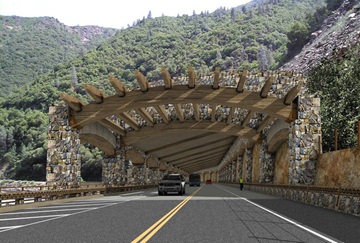
This artist's rendering suggests what the rock shed will look like once completed along State Route 140 west of Yosemite National Park.
Caltrans District 10 illustration
Once it was determined that a rock shed was viable for a project, it became clear that the original plan for traditional “cast-in-place” construction had to be reconsidered. Caltrans designers from District 10 (Stockton region, eastward to the Nevada border) including Grant Schuster and Caroline Reyes developed an innovative solution to construct a 750-foot, segmentally constructed launched rock shed structure on the same alignment that will be built outside of the rock fall zone and then launched into place.
The installed segments will provide shelter for workers so that the entire process takes place under the protective cover of the structure as each segment is moved into place.
The project construction has been split in two distinct construction projects. Phase 1, completed in 2021-2022 for $22.7 million, employed blasting operations and remote-controlled equipment to remove 147,000 tons of talus material and install cable net drapery to minimize additional rock fall.
Phase 2, which in 2019 was estimated to cost $175 million and take five years, is the rock-shed construction on the same alignment as the original road. It will consist of 11 pre-cast concrete segments and have an interior width of 40 feet. Its restraining base will be anchored by 200 rock anchors and 400 concrete micro piles.
The purpose of the project is to restore full access to State Route140 providing a reliable route within the limits of the Ferguson Slide area and to keep the roadway open to vehicular and bicycle traffic, including large commercial trucks, emergency vehicles, and recreational vehicles. It is needed because access to Yosemite National Park and the community of El Portal has been severely restricted the past 17 years, resulting in significant economic losses.
Route 25 Curve Alignment Restoration
Almost a decade ago, Caltrans addressed a safety concern in District 5 when it realigned a short portion of State Route 25 in San Benito County, approximately 32 miles south of the city of Hollister. That location had sustained a higher-than-average number of collisions when compared with similar roadways throughout the state.
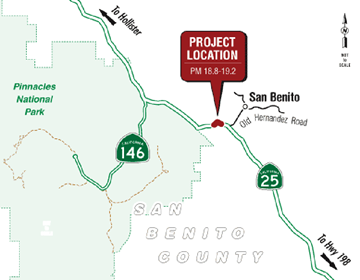
It only takes a minute to drive the detour along State Route 25 near San Benito, although a stoplight can cause further delays.
District 5 mapIn December 2015, construction was completed on the project where a tight curve was straightened by cutting back slopes through a hillside and realigning the roadway. Soon afterward, however, the cut slopes on both sides began to fail, and the newly constructed roadway needed to be closed for the safety of the traveling public.
Under an emergency project, a temporary detour was constructed to the east of the historic roadway alignment and continues functioning today with temporary stop signs with flashing beacons to allow traffic to continue. The Route 25 Curve Alignment Restoration will provide a permanent solution.
As soon as early 2024, Caltrans looks to complete flattening the cut slopes to 2:1 (horizontal to vertical dimensions) to reduce erosion, promote vegetation regrowth, and prevent repeated slope failure. The horizontal curves and banking of the roadway will allow vehicles to travel through the curve more safely.
Approximately 72,000 cubic yards of material will need to be excavated. The project will construct two 12-foot lanes with 4-foot outside shoulders. Because the existing right of way cannot accommodate the proposed flattening of the slopes, additional permanent right-of-way acquisition is required.
It is estimated that 17 blue oak trees and one valley oak tree may need to be removed to accommodate the proposed project. Impacts to trees will be offset by replacement planting within the project limits. In total, a minimum of 191 blue oak trees will be planted within the proposed planting areas. A three-year plant establishment period is proposed.
The project's estimated cost is $14 million, subject to change as progress continues.
State Route 39 Reopening Project
Whereas the closures of State Routes 140 and 25 described above were initiated in the 21st century, the same cannot be said for the shutdown of a 4.4-mile stretch of State Route 39 in the Angeles National Forest. That District 7 closure dates back to Edmund G. Brown’s first of four gubernatorial terms, the disco days of the late 1970s.
The two-lane highway heads north from Azusa in the San Gabriel Valley for 30 zigzaggy miles to State Route 2, also known as the Angeles Crest Highway. The northernmost segment of State Route 39 has been closed to public highway traffic since 1978 as the roadway is regularly damaged by landslides, flooding, falling rocks and forest fires. In 2003, the closed highway was opened to emergency crews after a Caltrans study showed reopening it would not harm wetlands, air and water quality, natural vegetation or threatened plants and animals.
Maintenance activities have included the cleaning of drainage culverts and the erection of a dirt berm. With these past improvements, the roadway is passable, but only open to emergency service vehicles.
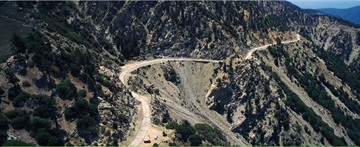
The fate of State Route 39's long-closed portion has not been determined, although several possibilities are being considered.
Caltrans District 7 photograph
Some people (business owners and recreational enthusiasts among them) adamantly want it reopened, while others (small-town residents concerned with traffic and pollution, and wildlife advocates) are just as spirited in their opposition. Caught in the middle are the estimated 417 bighorn sheep who call the region home. They often have been spotted crossing or even merely standing on the emergency road. The sheep, of which there are about 5,000 total in California, are protected and any injury or death caused by vehicles or road crews would represent a violation of state law.
Caltrans is contemplating ways to possibly reopen the long-closed 4.4-mile portion. Last December, the department hosted a public scoping meeting during which six project alternatives were presented and public input was solicited. The alternatives are:
- No build, which proposes to maintain the existing conditions of the roadway without any improvements.
- Minimum build, which proposes limited roadway restoration. Access to the roadway would be strictly for emergency service responders and maintenance access. The roadway would continue to be closed to public highway traffic.
- Active transportation access, which proposes to restrict access to the roadway to recreational related activities (e.g., enjoying vista views, hiking, biking, picnicking, camping, fishing, etc.) and allow only onsite shuttle service to operate and ferry national forest visitors through the restricted roadway adhering to a maximum speed of 15 mph and exercising extreme caution at well-marked wildlife crossings. This alternative also proposes two sustainable public parking areas, at both ends of the reopened stretch, to be constructed for visitors to park their vehicles and bikes. The main structural features include on major viaduct structure, two rock-sheds, and six soldier pile retaining walls.
- Full opening, which proposes to rehabilitate and reopen the closed segment of State Route 39 to public traffic and provide unrestricted access. A roundabout feature is also proposed at the intersection of State Routes 2 and 39. The main structural features include one major viaduct structure, two rock-sheds, four viaduct/wildlife crossing structures, and six soldier pile retaining walls.
- Viaduct construction, which proposes to construct a 4.4-mile-long standard two-lane elevated viaduct structure adjacent to the existing roadway. The continuous elevated viaduct would bypass the slide area and allow wildlife, slide debris, and water runoff to pass underneath the highway. The proposed bridge section would consist of a 10-foot-wide outside shoulder and a 12-foot-wide lane in each direction.
- Single travel lane, which proposes to construct a single travel lane having a total roadway width of 20 feet (12-foot travel lane with a 4-foot-wide shoulder on each side of the travel lane). The lane would be shared by all traffic with room to pull over and allow on-coming vehicles to pass safely.
Costs and timeframes for each of the six alternatives vary greatly. Caltrans continues to analyze the situation and related feedback, and looks to proceed with a finalized plan within a few years.
Sources: Bob Highfill, District 10 information officer; Brandy Rider, District 5 project manager; and Karl Price, District 7 senior environmental planner

